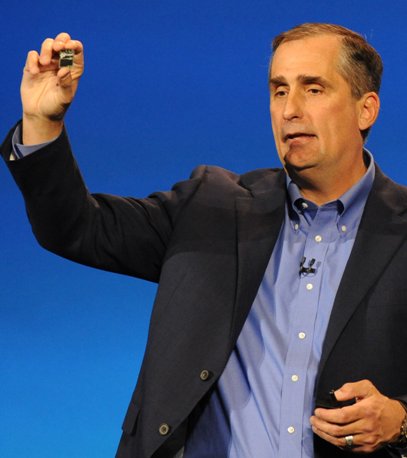
Wearables: The Latest Big Data Fashion Accessories
A lot of energy has been spent the last few days on the potential for so-called “wearable” computers to provide another large injection of information into our big data-crunching lives. Intel and other vendors unveiled numerous new wearables at CES this week that promise new possibilities for extracting personal information from people as they move about the physical world. The problem is: there’s no “there” there, at least not yet.
 |
|
| The Intel Edison chip is expected by this summer | |
Intel led the wearables charge at CES 2014 with the unveiling of Edison, a new dual-core, system-on-a-chip that’s based on the 29nm Quark technology that Intel unveiled in 2013. Expected to be available in the middle of 2014, Edison will deliver a full Pentium-class PC that’s the size of an SD card. It will run the Linux OS, be equipped with Wi-Fi and Bluetooth radios, consume relatively small amounts of power, come with its own app store, and be programmable using the Wolfram Language, the same folks helping to program the diminutive Raspberry Pi appliance that some are using to run Hadoop.
The chip giant demonstrated several new wearable “reference guides” on at CES that are based on Edison, including smart ear buds, a smart watch, a smart charging bowl, and a baby’s onesie that’s equipped with a built-in baby monitor (a “smart onesie,” as it were). The company doesn’t plan to be in the wearable manufacturing market, of course, but instead hopes that Edison will stimulate the wearables market and that its business partners will pick up the ball and run with it to create wearable devices that consumers and businesses will buy.
“With Edison the opportunities we believe are endless,” Intel CEO Brian Krzanich said during the CES keynote on Monday. “There’s so much creativity and capacity in this device.” To help make wearables palatable to the masses, Intel is partnering with three fashion firms, Barneys New York, the Council of Fashion Designers of America, and Opening Ceremony. It also launched the “Make It Wearable” contest, which will reward the top 10 wearable ideas with $1.3 million in prizes and, of course, the chance to have your business opportunity exploited by Intel.
Wearables are not exactly new, but they haven’t been able to rise above “geek chic” status and hit the mainstream. Athletes have been wearing sensors that monitor heart rate, breathing, and other biometric metrics for years, and smart watches have been available from Samsung, Sony, and Pebble (a Kickstarter project) for some time. Apple is expected to introduce its own smart watch soon, while Google has another long beta going with Glass, its smart eyeglass platform. Motorola (owned by Google) also has wearable headset computers designed for police.
 |
|
| Intel CEO Brian Krzanich shows off the Edison chip this week at CES | |
One of the hurdles to overcome before wearables can join the Internet of Things and start feeding lots of big and local data into the cloud is the overall lack of integration. Most wearables are highly specialized devices, and yet they require users to carry a second device, such as a smart phone, Krzanich says. “Wearables are not everywhere today because they aren’t yet solving real problems and they aren’t yet integrated with our lifestyles,” the Intel CEO says. “We’re focused on addressing this engineering innovation challenge.”
There’s no doubt that Edison ramps up hype level around wearables, but there’s a good chance it can help illuminate feasible business use cases as well, particularly in the law enforcement and healthcare segments. New research from Forrester indicates that the wearables market may be on the verge of a break out year. “There’s no doubt about it: The wearables market is suffering from a hype bubble,” writes Forrester VP J. P. Gownder in a new report issued this week called The Enterprise Wearables Journey.
But just as the Internet turned out to actually be a world-changing phenomenon, Gownder believes that so, too, can wearables, which he predicts will be worn by 10 percent of urban population within five years.
 |
|
| Sensors in the “smart onsie” detect the baby is waking up… | |
“Wearable devices–and the apps, software, and services that make those wearables truly valuable–will change the way workers do their jobs and how consumers manage their lives,” Gownder writes. “Enterprises need to start putting together a road map for thinking about how wearables can improve their businesses over the next few years.”
 |
|
| …and that signals the “smart bottle warmer” to begin heating up. | |
Wearables powered by technology like Edison have the capability to add another wrinkle to the data management and utilization challenge faced by many firms. Combining location data with biometric data feeds, pictures, and other localized information gathered at the point-of-person will uncover new opportunities, as well as new challenges.
Security has the potential to be a deal-breaker for wearables. Smart phones, tablets, and other Internet-connected devices are already some of the most poorly protected computers we use today. When you consider the total lack of patching and wide-open state of security in Wi-Fi routers and modems, as detailed by security expert Bruce Schneier in a recent column, the opportunity to add even more entry points will exacerbate the problem.
“The Internet of Things will only make this problem worse, as the Internet–as well as our homes and bodies–becomes flooded with new embedded devices that will be equally poorly maintained and unpatchable,” he writes.
Intel is trying to get ahead of the big security challenges by launching its new Intel Security brand and by offering to include McAfee anti-malware security for free on all mobile devices.
Related Items:
Datanami Dishes on ‘Big Data’ Predictions for 2014
Intel Goes Graph with Hadoop Distro






























